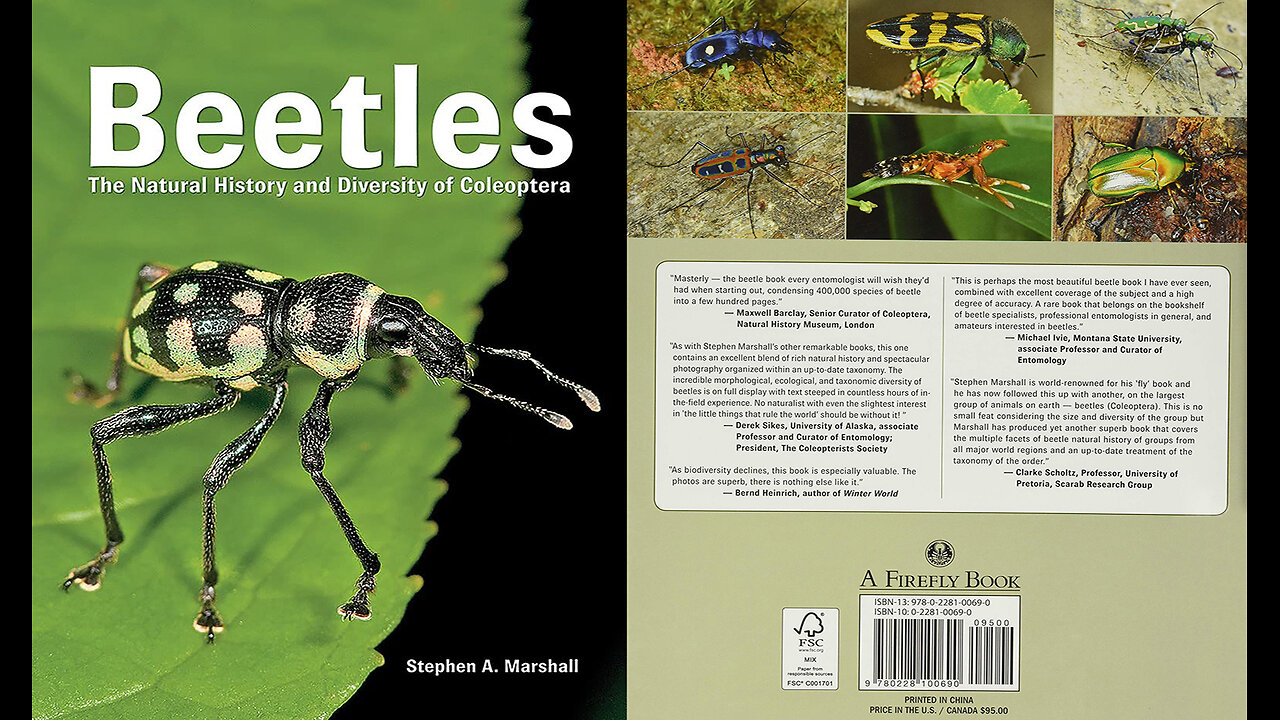Premium Only Content

Beetles: The Natural History and Diversity of Coleoptera
Beetles: The Natural History and Diversity of Coleoptera
https://amzn.to/3s1kNK8
Bugs and Insects Books
https://tinyurl.com/bugs-and-insects-books
An accessible but comprehensive overview of beetles, illustrated with 4,500 photographs.
Among Stephen Marshall's many other natural history titles are Insects: Their Natural History and Diversity and Flies: The Natural History and Diversity of Diptera, two of the most respected books on the insect world published in the last 20 years. More admirable than the books' rigorous science, however, is that they are wholly suitable for a lay audience, including student readers from high school on. The books have been adopted as classroom texts and assigned as required reading at the university level and are on the references shelves of many practicing entomologists.
In Beetles: The Natural History and Diversity of Coleoptera, Marshall has again applied his deep knowledge of the insect world. Comprehensive and packed with 27 pages of richly illustrated keys and 4,500 color illustrations, it provides the reader with a colorful and enjoyable introduction to the natural history of a huge group of organisms, along with an overview of the diversity of fascinating families included in the group. The subject of this book is an enormous one, since the beetles, or Coleoptera, include almost 400,000 named species.
Marshall opens with a description of what makes a beetle a beetle, and then introduces the natural history of the order with copious examples and explanations.
Part one of the book includes:
Life Histories of Beetles: Form and Function: Eggs; Larvae; Pupae, Prepupae and Cocoons; Adults; Courtship and Mating Behaviors
Defense and Deception: Tanks, Tricks and Coleopteran; Chemical Warfare; Brilliance and Bioluminescence in the Beetles
Freshwater and Marine Beetles: Freshwater beetles; Marine beetles
Beetle Associations with Fungi, Dung and Carrion: Beetles and Fungi; Beetles and Dung; Beetles and Dead Bodies
Beetles, Plants and Plant Products: Beetles and Flowers; Phytophagy and Beetle Diversity; Aposematic Beetles and Their Plant Hosts; Beetles as Agricultural and Garden Pests; Beetles and Biological Control of Weeds; Beetles and Trees
Beetles and Other Animals: Dangerous Beetles; Coleoptera and Culture; Beetles Indoors; Rare, Endangered and Threatened Beetles; Beetles, Birds and Wild Mammals; Beetles and Other Invertebrates.
Part two of Beetles is a guided tour of the diversity of the order, with fascinating stops for all of the world's 180 or so families of beetles as well as most of the significant subfamilies. Thousands of photos, almost all taken in the field by the author, are used to capture the range of form and function in each family, with pages of examples of the popular groups -- such as fireflies, tiger beetles, jewel beetles -- but also with unique photographs of little-known groups ranging from long-lipped beetles to the rarest rove beetles. Essential information about importance, range, behavior and biology is provided for each group, and easily used photographic keys to most families are provided for those wishing to use the book as an identification guide.
The profusely illustrated keys in Beetles, linked to the unprecedented photographic coverage of the world's beetle families and subfamilies, enable readers to identify most families of beetles quickly and accurately, and to readily access information about each family as well as hundreds of distinctive genera and species.
Like its companion titles, Insects and Flies, Beetles will be welcomed by the scientific, academic and naturalist communities, including the next generation of students of entomology.
-
 1:21:55
1:21:55
Kim Iversen
3 hours agoMultiple States To BAN mRNA Vaccines | They Want to Make Protesting Illegal, Here's How
22.1K23 -
 7:34:25
7:34:25
Dr Disrespect
10 hours ago🔴LIVE - DR DISRESPECT - WARZONE - IMPOSSIBLE TRIPLE THREAT CHALLENGE
158K20 -
 37:44
37:44
Glenn Greenwald
7 hours agoGlenn On Tearing Down the Military Industrial Complex, Exposing Pro-Israel Indoctrination, and More | SYSTEM UPDATE #411
56.7K83 -
 4:04:20
4:04:20
Nerdrotic
6 hours ago $37.70 earnedAmazon Takes 007! Hollywood is Lost, Disney Cancels WHO? | Friday Night Tights 342 /w ItsAGundam
125K23 -
 43:27
43:27
Tucker Carlson
6 hours agoRay Dalio: America’s Hidden Civil War, and the Race to Beat China in Tech, Economics, and Academia
115K136 -
 56:56
56:56
Candace Show Podcast
6 hours agoEXCLUSIVE: Taylor Swift Will Be Deposed. | Candace Ep 150
105K120 -
 1:03:52
1:03:52
IsaacButterfield
3 hours ago $1.05 earnedRepublican Vs 25 Transgender Activists | Jewish Outrage | Lizzo Loses All the Weight
15.9K3 -
 1:10:23
1:10:23
Edge of Wonder
7 hours agoChinese Biochips Hacking Minds? Quantum Control & Journey Song Mandela Effect
34K3 -
 2:15:46
2:15:46
Quite Frankly
10 hours ago"Ghosts, Robotics, and OBE's" ft. Dr. Albert Taylor 2/21/25
41.7K15 -
 55:52
55:52
LFA TV
1 day agoMaking Germany Great Again | TRUMPET DAILY 2.21.25 7PM
28.1K3